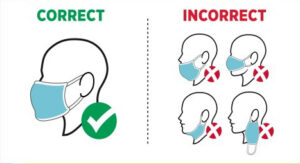It is no myth that masks are important in the fight against COVID-19.
The American Medical Association states there are risks for transmission that masks can prevent. The AMA advises that we protect ourselves and those around us by wearing a mask.
Affinity Health Services reminds all that it not only matters if you wear a mask, but also how you wear it. Wearing a mask to protect against coronavirus has become part of daily life.
Although wearing a mask is one of the most important things you can do to prevent coronavirus infection, there are still many misunderstandings about:
- How safe and effective masks are
- How to use them properly
- When and where masks are needed
Here are more facts to help explain debunk the myths about coronavirus masks, according to the CDC (Centers for Disease Control and Prevention) and Healthgrades.com
Myth No. 1: Face masks are a substitute for social distancing.
Wearing a face mask keeps me from spreading the virus, so I don’t need to worry about getting close to others.
Fact: The CDC recommends widespread use of simple cloth face coverings to help prevent transmission of COVID-19 by people who have the virus but don’t know it. But it’s not a substitute for physical distancing. Staying at least 6 feet apart from others while in public is still the most important tool to stopping the spread of the virus (SARS-CoV-2), according to the CDC. That’s because the virus spreads mainly by respiratory droplets at close range, and simple face masks can’t filter 100% of small virus particles from droplets or the air you breathe in.
COVID-19 can also spread through the air, but it is more likely in indoor spaces where virus-contaminated respiratory droplets and aerosols generated from an infected person(s) can accumulate. To reduce your risk of contracting COVID-19, avoid indoor public spaces with lots of people and poor ventilation.
Keep in mind that patients infected with SARS-CoV-2 who do not show symptoms, or who have very few symptoms, can still spread the virus through talking, coughing or sneezing, especially in close proximity to other people.
Myth No. 2: A face mask can actually make me more susceptible to COVID-19.
People who wear face masks are constantly adjusting them and touching their faces more often…it actually increases my risk of contracting the virus.
Fact: It’s true that people who wear masks tend to touch their face more often than those who don’t, which can paradoxically result in an increased risk of infection. But you can reduce your risk with frequent handwashing and knowing how to properly put on and remove your mask, taking care not to touch the front of it. Follow CDC’s guidance on how to wear cloth face coverings.
Myth No. 3: Only an N95 mask will help me.
They say that an N95 mask helps protect the wearer from getting the virus, while a surgical or cloth mask is really to help protect others in case the wearer has the virus.
Fact: Actually a type of respirator, an N95 mask is designed to block 95% of very small particles. Although cloth masks and N95 masks have different purposes, both are intended to slow the spread of COVID-19. Mounting evidence shows that cloth masks do filter small particles, albeit not as much as the N95. Certain cloth masks can filter out up to 50% of fine particles. So wearing a cloth mask protects you and those around you. And common sense suggests that some protection is better than none. But wearing a cloth face mask should always be combined with frequent handwashing and social distancing.
Also, keep in mind that surgical masks and N95 respirators are in short supply and should be reserved for healthcare workers or other medical first responders, as recommended by CDC guidance.
Myth No. 4: I don’t need to wash my mask after each use.
Washing a cloth mask after each use can be time-consuming and inconvenient, so I tend to wear my mask several times before washing.
Fact: Though it’s not particularly convenient, cloth face coverings should be washed after each use, according to the CDC. It’s fine to launder them with other clothes in the washing machine, using the warmest appropriate water setting for the material. You can also wash by hand using 4 teaspoons of bleach diluted in 1 quart of water. And be sure to dry your masks on the highest setting, or lay flat to air dry in direct sunlight, if possible. If you have a disposable mask, let it sit for 10-14 days to allow the virus (if present) to die out.
Myth No. 5: Any mask I can find, or make, will do.
Anything that covers my nose and mouth, regardless of how it’s made, will keep me from spreading the virus to others.
Fact: Cloth face coverings are generally simple to make, and can be made at low cost using household items. But a cloth mask should include multiple layers of fabric to provide the most protection. The CDC website offers directions for no-sew masks using common materials made of tightly woven cotton, such as bandannas and T-shirts. Neck gaiters are the least effective.
Myth No. 6: Wearing a face mask can make me sick.
Face masks allow carbon dioxide to accumulate, which will make it hard for me to breathe and could make me sick.
Fact: Many people have heard that breathing in CO2 (also known as hypercapnia) from wearing a mask can cause symptoms like dizziness, lightheadedness, headache, and shortness of breath. But because most people (apart from healthcare workers) are wearing a mask for a short period of time, they likely won’t experience anything more than a mild headache. Also, be aware that once a mask gets wet (perhaps from exhalation), it begins to lose its effectiveness and will need to be washed or replaced.
Myth No. 7. Wearing a face mask means I’m scared, or weak.
Wearing a face mask is a sign that I’ve “given in” to the virus.
Fact: Myths abound about why people choose to wear—or not to wear—a face mask. Some say it makes a certain political statement, or means you’re opposed to reopening the country. Others think it implies weakness or fear. The truth is, wearing a face mask simply means you understand the nature and risks of spreading a highly contagious virus, and are concerned about the health and well-being of others. It’s hard to find a better reason to wear one than that.

